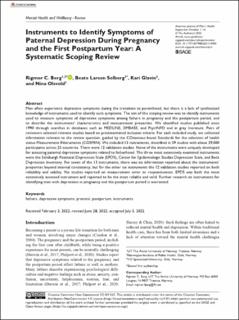| dc.contributor.author | Berg, Rigmor | |
| dc.contributor.author | Solberg, Beate | |
| dc.contributor.author | Glavin, Kari | |
| dc.contributor.author | Olsvold, Nina | |
| dc.date.accessioned | 2022-11-25T12:13:10Z | |
| dc.date.available | 2022-11-25T12:13:10Z | |
| dc.date.created | 2022-10-12T09:40:19Z | |
| dc.date.issued | 2022 | |
| dc.identifier.citation | American Journal of Men's Health. 2022, 16 (5), | en_US |
| dc.identifier.issn | 1557-9883 | |
| dc.identifier.uri | https://hdl.handle.net/11250/3034100 | |
| dc.description | Creative Commons Non Commercial CC BY-NC: This article is distributed under the terms of the Creative Commons Attribution-NonCommercial 4.0 License (https://creativecommons.org/licenses/by-nc/4.0/) which permits non-commercial use, reproduction and distribution of the work without further permission provided the original work is attributed as specified on the SAGE and Open Access pages (https://us.sagepub.com/en-us/nam/open-access-at-sage). | en_US |
| dc.description.abstract | Men often experience depressive symptoms during the transition to parenthood, but there is a lack of synthesized knowledge of instruments used to identify such symptoms. The aim of this scoping review was to identify instruments used to measure symptoms of depressive symptoms among fathers in pregnancy and the postpartum period, and to describe the instruments’ characteristics and measurement properties. We identified studies published since 1990 through searches in databases such as MEDLINE, EMBASE, and PsycINFO and in gray literature. Pairs of reviewers selected relevant studies based on predetermined inclusion criteria. For each included study, we collected information relevant to the review question, guided by the COnsensus based Standards for the selection of health status Measurement INstruments (COSMIN). We included 13 instruments, described in 59 studies with about 29,000 participants across 25 countries. There were 12 validation studies. None of the instruments were uniquely developed for assessing paternal depressive symptoms related to fatherhood. The three most extensively examined instruments were the Edinburgh Postnatal Depression Scale (EPDS), Center for Epidemiologic Studies Depression Scale, and Beck Depression Inventory. For seven of the 13 instruments, there was no information reported about the instruments’ properties beyond internal consistency, but for the other six instruments the 12 validation studies reported on both reliability and validity. No studies reported on measurement error or responsiveness. EPDS was both the most extensively assessed instrument and reported to be the most reliable and valid. Further research on instruments for identifying men with depression in pregnancy and the postpartum period is warranted. | en_US |
| dc.language.iso | eng | en_US |
| dc.publisher | Sage | en_US |
| dc.rights | Navngivelse-Ikkekommersiell 4.0 Internasjonal | * |
| dc.rights.uri | http://creativecommons.org/licenses/by-nc/4.0/deed.no | * |
| dc.subject | instruments | en_US |
| dc.subject | postpartum | en_US |
| dc.subject | prenatal | en_US |
| dc.subject | depressive symptoms | en_US |
| dc.subject | fathers | en_US |
| dc.title | Instruments to identify symptoms of paternal depression during pregnancy and the first postpartum year: A systematic scoping review | en_US |
| dc.type | Peer reviewed | en_US |
| dc.type | Journal article | en_US |
| dc.description.version | publishedVersion | en_US |
| dc.rights.holder | © The Author(s) 2022 | en_US |
| dc.source.pagenumber | 1-16 | en_US |
| dc.source.volume | 16 | en_US |
| dc.source.journal | American Journal of Men's Health | en_US |
| dc.source.issue | 5 | en_US |
| dc.identifier.doi | 10.1177/15579883221114984 | |
| dc.identifier.cristin | 2060722 | |
| dc.relation.project | Norges forskningsråd: 282167 | en_US |
| cristin.ispublished | true | |
| cristin.fulltext | original | |
| cristin.qualitycode | 1 | |

